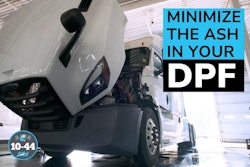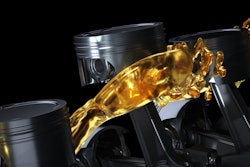An engine oil sample is a lot like a blood sample in that it can show details and warning signs of maintenance problems long before they become catastrophic, but many fleets don’t go through the effort.
Whether it’s a lack of time to pull the sample or a lack of willingness to go through the effort, Chevron Lubricants Business Consultant Shelly Eckert joins the 10-44 this week to dive into those excuses and poke some holes in them.
Contents of this video
00:00 Sampling engine oils
02:38 Oil changes
03:24 Taking the engine oil sample
05:28 Sampling as an insurance policy
07:51 The lifeline of the engine
08:44 Cost of engine oil sampling
09:33 Trade-in trucks and engine maintenance
Jason Cannon (00:00):
This week's 10-44 is brought to you by Chevron Delo 600 ADF, ultra-low ash diesel engine oil. It's time to kick some ash.
(00:09):
Fleets have a lot of excuses for not sampling their engine oil, and this week we're going to look at all of them. You're watching CCJs 10-44, a weekly webisode that brings you the latest trucking industry news and updates from the editors of CCJ. Don't forget to subscribe and hit the bell for notifications so you'll never miss an installment of 10-44.
(00:29):
Hey everybody, welcome back. I'm Jason Cannon, and my co-host is Matt Cole. An engine oil sample is a lot like a blood sample. It can show details and warning signs of problems long before they become catastrophic, yet still, many fleets don't go through the effort.
Matt Cole (00:44):
Whether it's a lack of time to pull the sample or a lack of willingness to go through the effort, a few minutes of work and a few dollars can save days, if not weeks, of downtime and thousands of dollars in repairs and lost productivity.
Jason Cannon (00:55):
Chevron Lubricants Business Consultant, Shelly Eckert, joins the 10-44 this week. Now, Shelly cut her teeth in the lab, so she's really passionate about how effective testing can be for fleets, and she's heard all of the reasons and all of the excuses why companies won't do it. Like...
Matt Cole (01:11):
"I don't care about extending oil drain intervals, so I don't need to sample."
Shelly Eckert (01:15):
That's a very valid point that you hear. People talk about that. And there's a lot of fleets that do test and see value in it. But I have a great story. Years ago, I was doing a drainable study. The instructions to the fleet was to take samples every 5,000 miles and send them into the laboratory to see how far we could go with the engine oil, but instead, what happened was all the samples were sent in at the same time.
(01:42):
So I had about five samples in the lab, and as they were transitioning through the lab, they were getting worse, the criticality was increasing, and about the fourth or fifth sample, I picked up the phone and called the vice president of maintenance, and I said, "You're going to blow a rod through the engine block." And he said, "Yes, that happened yesterday." And that fleet, at that point, because they had that failure, they got onto a solid oil analysis program and see the value in it.
(02:12):
Some of it is to make buying decisions. Some of it is to have seen which engines is outperforming better. Some of it is to decide when you should trade the truck before all the maintenance expenses kick in. Some of the reasons would be to back you up for a warranty claim to show that you were doing oil analysis and taking care of the abnormalities or severities of the reports. There's a lot of value in it.
Jason Cannon (02:38):
"If I'm going to sample it, I might as well change it because I'm stopping the truck either way."
Shelly Eckert (02:42):
And sometimes, Jason, changing the oil is what fixes the problem. But that doesn't fix any coolant leaks. That doesn't fix any fuel dilutions. It doesn't fix an engine that's overheating and oxidizing and therefore increasing your viscosity and therefore losing your fuel economy benefit. But the thing about an oil analysis program is that if you set it up properly and everybody has all the decision-makers involved, you set up the equipment list with the lab so that you don't have to keep telling them what make and model the engine is, and then, you set up sampling procedures.
Matt Cole (03:24):
"I don't have time to pull a truck just to try and catch a quarter cup of engine oil."
Shelly Eckert (03:28):
Some trucks will come from the factory with sampling valves. This is a push-button valve. This is an inline valve, so there's several different valves that you can use. That's the number one way to draw a sample is to use a sampling valve that's on the engine block. Okay? That's the cleanest way to do it and the most consistent way to do it. You just have to flush the line, and then you draw a sample.
(03:56):
The second way to take a sample without changing the oil or taking it to the third way I'm going to talk about is to use a vampire pump, which you just end up taking a sample bottle, which I happen to have a Chevron LubeWatch sample bottle, which is very easy. You can't see it, but there's a fill line on the bottles to tell a technician where to stop taking the sample at. You take the white cap off, which I'm not going to do because it's sealed right now. You just twist it on here. You take tubing that you can get from the lab, put it down in here. Then you put the other end of the tubing down into the engine, and you just pump it, pump it, pump it, and it takes the sample out. It's pretty simple.
(04:50):
The third way, and the most common way because it's ease, is to take a sample when you're draining the oil, and that's messy. It's messy, and it's not consistent because the instructions are you're to take it at mid-drain. Well, it's easier for a technician to take a sample when he first unplugs, and it's less mess messy. And then, what you define as mid-drain, and what I define as mid-drain are two different things. So sometimes, if you get it too early or too late, you could end up with a sample that is full of ghosts, meaning the wear's really not there or the contaminants are not there.
Jason Cannon (05:29):
"If I'm using the right oil on the right interval, there's no reason to sample it because I'm doing everything the OEM says I'm supposed to do."
Shelly Eckert (05:36):
I've heard that too, but I look at sampling as an insurance policy, a cheap insurance policy. So I had a situation recently that the oil had just been changed, truck left, and the engine seized. And of course, they're not doing oil analysis, so it was an autopsy sample to find out what happened, which when an engine sees us like that, you can see all kinds of things going on in that oil analysis' results.
(06:04):
But if you're looking at it as an insurance, and then you're going to be more proactive doing preventative maintenance than reactive, you're actually saving a ton of money. You're saving it in unscheduled downtime. You're saving it on making sure that you have the parts that you need to make the repairs are in stock, which has been challenging for the last two years with the supply chain. But you're scheduling it so you don't get stuck with a load of goods out on the road because if that truck's not moving, it's not making any money.
Matt Cole (06:36):
"Oil is cheap, so just change it," Shelly says she hears this one a lot, and her response follows a quick word from 10-44 sponsor Chevron Lubricants.
Jason Cannon (06:44):
Protecting your diesel engine and its aftertreatment system has traditionally been a double-edged sword. The same engine oil that is so essential to protecting your engine's internal parts is also responsible for 90% of the ash that is clogging up your DPF and upping your fuel and maintenance costs. Outdated industry thinking still sees a trade-off between engine and emission system protection, and Chevron was tired of it, so they spent a decade of R&D developing a no-compromise formulation.
(07:09):
Chevron Lubricants developed a new ultra-low ash diesel engine oil that is specifically designed to combat DPF ash clogging. Delo 600 ADF with OMNIMAX technology cuts sulfate ash by a whopping 60%, which reduces the rate of DPF clogging and extends DPF service life by two and a half times. And just think what you can do with all the MPGs you're going to add from cutting your number of regens. But Delo 600 ADF isn't just about aftertreatment. It provides complete protection, extending drain intervals by preventing oil breakdown. Before, you had to choose between protecting your engine or your aftertreatment system, and now you don't. 600 ADF from Delo with OMNIMAX technology, it's time to kick some ash.
Shelly Eckert (07:51):
Well, that's funny because I get beaten up all the time over oil because of oil.
(08:00):
It should be about one or 2% of the maintenance spend. That is correct. However, the oil is the lifeline of the engine. A lot of us use the word blood of the engine. So it's going to tell you what is wrong with you. It's no different than you going to the doctor and getting blood work, and then the doctor tells you how you need to lower your cholesterol, for example. Oil analysis is the same thing. It just doesn't require doctors. Chemists, yes. Doctors, no. Because I came from doing oil analysis, I don't look at it that way. I look at it as a means to solve problems versus trying to sell them a different product.
Matt Cole (08:44):
"Sampling's expensive."
Shelly Eckert (08:46):
The labs will work with the fleets to create a return on investment, and part of that calculation includes the cost of the sample, includes the labor that it takes to take a sample, the time to look at a report, which is nothing, once you're comfortable with reading a report or reading the analysis and getting a quarterly business review by your rep. But you've got to set up the program correctly. And to answer your question regarding the cost, that all depends on what you're looking for. And typically, when you do an oil analysis program, you want to jump onto a Chevron LubWatch program because our buying power of creating an oil analysis program is much more effective than if you go straight to the laboratories.
Jason Cannon (09:33):
"I trade my truck every few years, so I'm not really worried about the engine long-term."
Shelly Eckert (09:37):
There are fleets now that are having to keep their trucks longer, so they are looking at the health of the equipment. Some of them used to be trading the trucks at 350, now they've gone to 500. One of mine went from 500 to 600,000 miles, and that changes the maintenance. It requires more maintenance.
Jason Cannon (10:01):
That's it for this week's 10-44. You can read more on ccjdigital.com. While you're there, sign up for our newsletter and stay up to date on the latest in trucking industry news and trends. If you have any questions or feedback, please let us know in the comments below. Don't forget to subscribe and hit the bell for notifications so you can catch us again next week.










